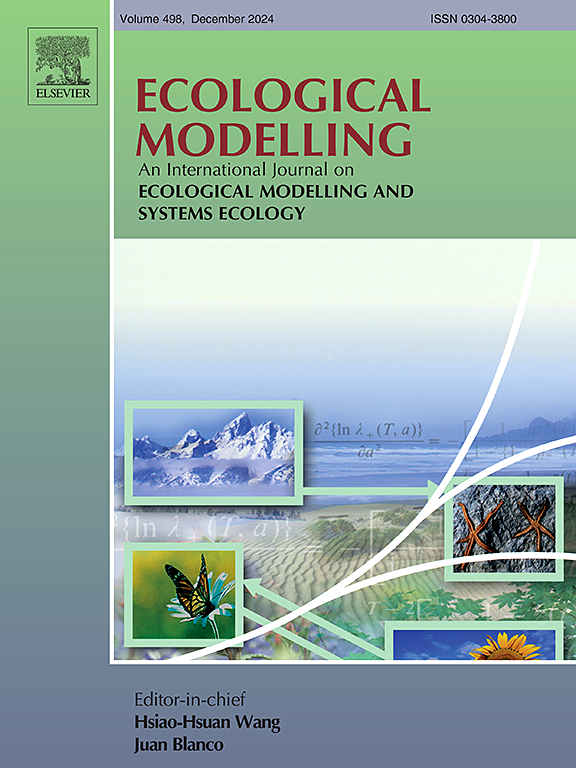A process-based dynamic modelling study of the impact of discharge water from shrimp culture on riverine nitrogen cycling: A case study
IF 2.6
3区 环境科学与生态学
Q2 ECOLOGY
引用次数: 0
Abstract
Shrimp is the primary aquaculture product exported from India in the global market. The shrimp industry contributes to the economic boom in the coastal provinces of India. However, shrimp culture imposes several externalities on the local ecosystem. One of the vital concerns is the nutrient-rich, chemically manipulated culture water discharge, which causes violations of sustainable and cleaner shrimp culture protocols. This study aims to understand the impacts of culture water on the nitrogen cycle of the river. The water is periodically released back into the river through a canal from the shrimp farms. This study was conducted by building a process-based system dynamic model following modelling protocols. The model was simulated, calibrated, and validated with the observed data collected from periodic sampling from the river, shrimp farms, and canals. Seven state variables were considered, and sediment nitrogen was treated as a single state variable. The interrelationship between different state variables was established by the inflows and outflows, incorporating several parameters. Study results indicate that NOx (nitrate and nitrite) is the main nutrient influx from the culture water. The model is a good predictor for the water column nitrogen components. The ecological functionality by different rate parameters of biotic components (Zooplankton and Phytoplankton) are not sensitive for this model's nitrogenous state variables. By the model outcomes, no direct relation between shrimp culture and the abundance of biotic components of this model can be established. Sediment nitrogen acts as the sink for the water column nitrogen components. This modelling study focuses on one of the river's vital regulatory ecosystem services, i.e., the nitrogen cycle. This model can be implemented to predict the impacts of any water discharge from such production on the nitrogen cycle of a lotic system. The study is important for establishing viable production protocols to achieve a sustainable balance between the shrimp production industry and the ecosystem.
对虾养殖排放水对河流氮循环影响的过程动态建模研究——以实例为例
虾是印度出口到全球市场的主要水产养殖产品。虾业为印度沿海省份的经济繁荣做出了贡献。然而,虾养殖给当地生态系统带来了一些外部性。其中一个重要问题是营养丰富的化学处理的养殖水排放,这导致违反可持续和更清洁的虾养殖协议。本研究旨在了解培养水对河流氮循环的影响。这些水定期通过一条运河从虾场排放回河中。本研究遵循建模协议,建立了一个基于过程的系统动态模型。利用定期从河流、虾场和运河中收集的观测数据对该模型进行了模拟、校准和验证。考虑7个状态变量,将沉积物氮作为单一状态变量处理。通过流入和流出建立了不同状态变量之间的相互关系,并纳入了几个参数。研究结果表明,氮氧化物(硝酸盐和亚硝酸盐)是培养水中流入的主要营养物质。该模型能较好地预测水柱氮组分。生物组分(浮游动物和浮游植物)不同速率参数的生态功能对该模型的氮态变量不敏感。从模型结果来看,该模型中对虾养殖与生物成分丰度之间没有直接关系。沉积物氮作为水柱氮组分的汇。这个模型研究的重点是河流的一个重要的调节生态系统服务,即氮循环。该模型可用于预测此类生产的任何水排放对lotic系统氮循环的影响。该研究对于建立可行的生产方案以实现对虾养殖业与生态系统之间的可持续平衡具有重要意义。
本文章由计算机程序翻译,如有差异,请以英文原文为准。
求助全文
约1分钟内获得全文
求助全文
来源期刊

Ecological Modelling
环境科学-生态学
CiteScore
5.60
自引率
6.50%
发文量
259
审稿时长
69 days
期刊介绍:
The journal is concerned with the use of mathematical models and systems analysis for the description of ecological processes and for the sustainable management of resources. Human activity and well-being are dependent on and integrated with the functioning of ecosystems and the services they provide. We aim to understand these basic ecosystem functions using mathematical and conceptual modelling, systems analysis, thermodynamics, computer simulations, and ecological theory. This leads to a preference for process-based models embedded in theory with explicit causative agents as opposed to strictly statistical or correlative descriptions. These modelling methods can be applied to a wide spectrum of issues ranging from basic ecology to human ecology to socio-ecological systems. The journal welcomes research articles, short communications, review articles, letters to the editor, book reviews, and other communications. The journal also supports the activities of the [International Society of Ecological Modelling (ISEM)](http://www.isemna.org/).
 求助内容:
求助内容: 应助结果提醒方式:
应助结果提醒方式:


